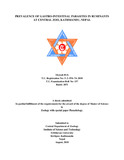Please use this identifier to cite or link to this item:
https://elibrary.tucl.edu.np/handle/123456789/1465| Title: | Prevalence of Gastro-Intestinal Parasites in Ruminants at Central Zoo, Kathmandu, Nepal |
| Authors: | Pun, Tejab |
| Keywords: | Parasites;Ruminants |
| Issue Date: | 2018 |
| Publisher: | Central Department of Zoology |
| Abstract: | The present study was done in Central Zoo of Nepal to find out the prevalence of gastrointestinal parasites and basic management practice in present ruminant species. Zoo is the special place where wild animals are kept for exhibition which plays crucial role in recreation, relaxation, education, research and so on. Ruminants are herbivores with four chambered stomach. They are also get infected frequently by parasites. So, present study was conducted to find the parasitic infections in ruminants. A total of 104 fecal samples were collected from ruminants available at zoo in two different seasons' viz. winter (56) and summer (48) with the help of zookeeper. Fecal samples were preserved in 2.5% Potassium dichromate (K 2 Cr 2 O ) in 25ml sterile vial and transported safely to laboratory of Central Department of Zoology, Tribhuvan University, Kirtipur, Kathmandu, Nepal for microscopic observation. Concentration method (flotation and sedimentation) were employed to recover helminth eggs whereas iodine smear method was employed to recover protozoan cysts. Gastro-intestinal parasites were identified by microscopic examination. Results revealed overall prevalence of 59% parasitic infection whereas seasonal were 55% and 62% in winter and summer respectively. Only one protozoan, Eimeria sp. (Eimeria without micropyle (26%) and Eimeria with micropyle (15%)) was found and three helminth, nematode eggs were recorded with highly prevalent Trichostrongylus sp. (39%) followed by Haemonchus sp. (4%) and Strongyloides sp. (2%). No cestode and trematode were found during study period. Blue Sheep (Pseudois nayaur), Himalayan Goral (Naemorhedus goral) and Sambar Deer (Rusa unicolor) were found to be highly infected with intestinal parasites whereas Barking Deer (Muntiacus muntjak) showed lowest. Through interview and observation, management practice was found to be quite systematic but still care and deworming practice should be more effective. 7 |
| URI: | http://elibrary.tucl.edu.np/handle/123456789/1465 |
| Appears in Collections: | Zoology |
Files in This Item:
| File | Description | Size | Format | |
|---|---|---|---|---|
| Tejab_Thesis_2018.pdf | 3.19 MB | Adobe PDF |  View/Open |
Items in DSpace are protected by copyright, with all rights reserved, unless otherwise indicated.
